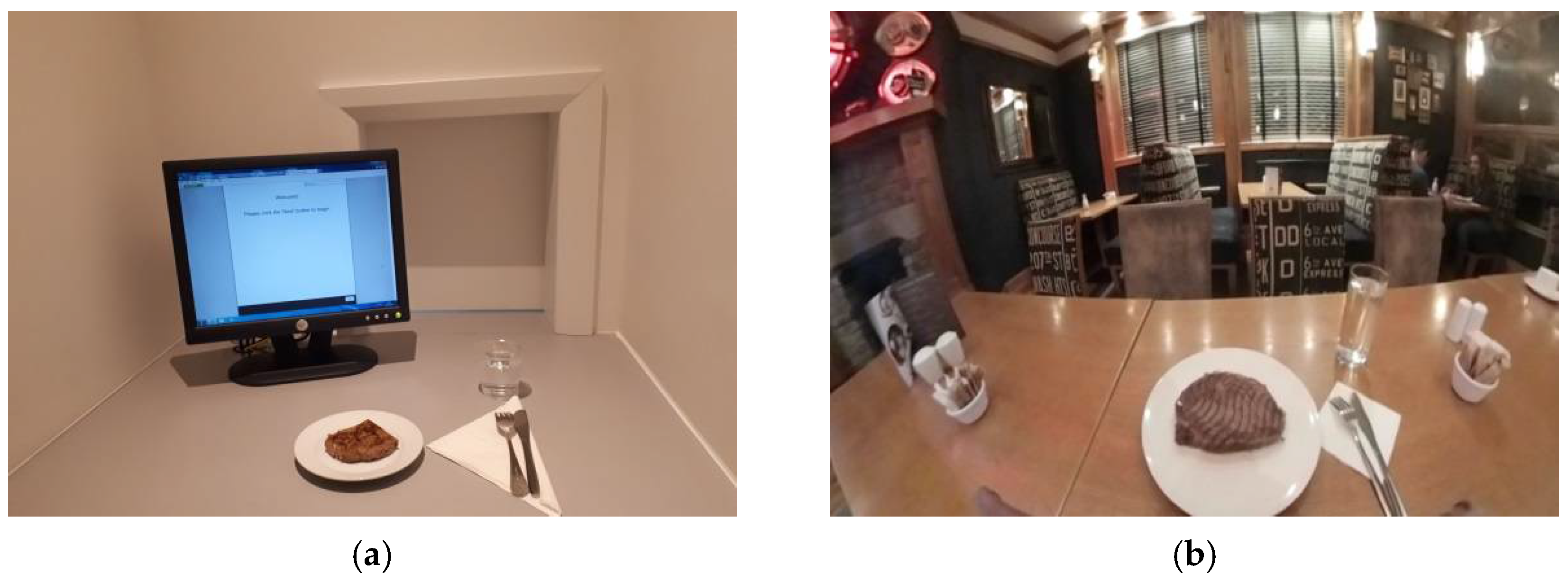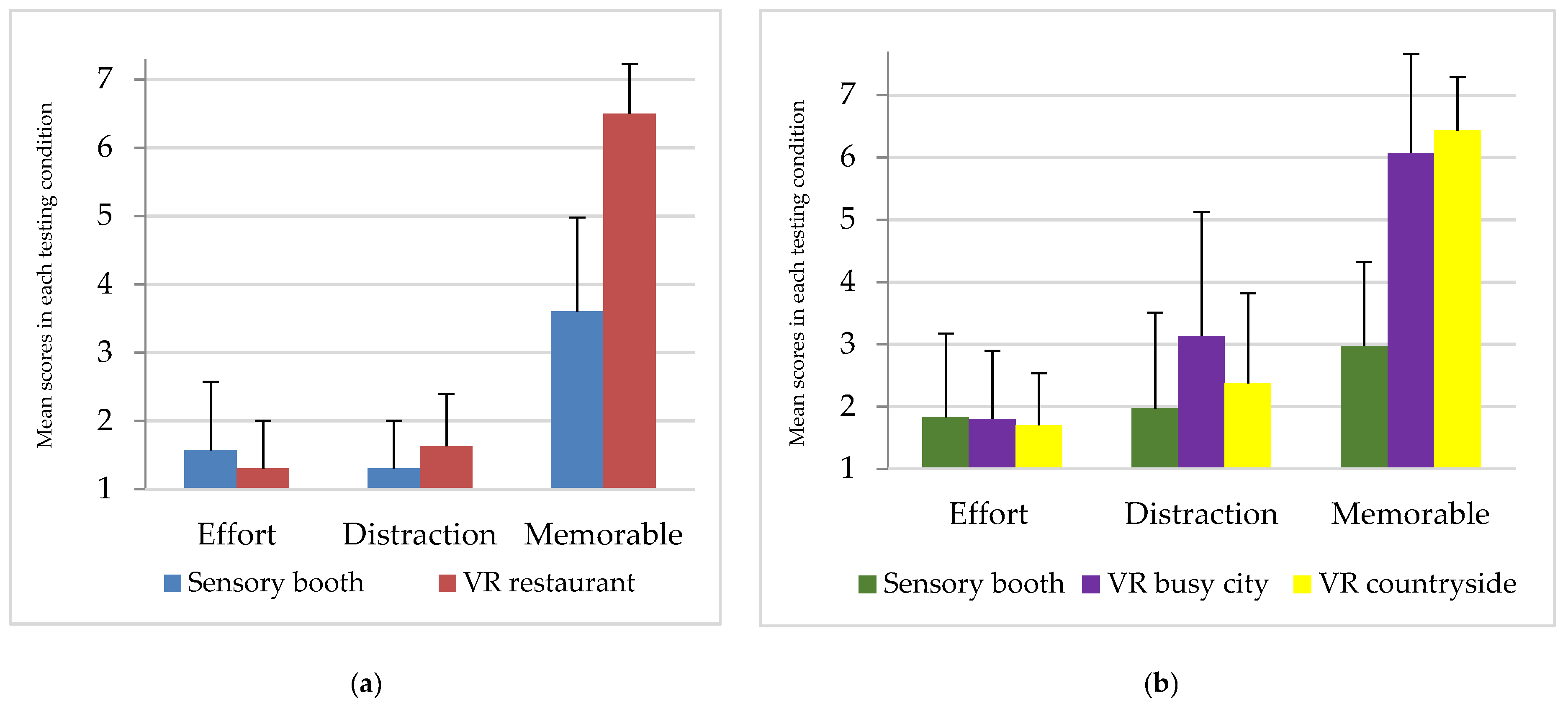Exploring the Effects of Immersive Virtual Reality Environments on Sensory Perception of Beef Steaks and Chocolate
Abstract
1. Introduction
2. Materials and Methods
2.1. Participants
2.2. Product Stimuli and Sensory Procedure
2.2.1. Beef Trial
2.2.2. Chocolate Trial
2.3. Contextual Settings
2.3.1. Beef Trial
2.3.2. Chocolate Trial
2.4. Data Analysis
3. Results and Discussion
3.1. The Effect of the Surrounding Environment on Participants’ Hedonic Ratings of Beef Steaks
3.2. The Effect of the Surrounding Environment on Participants’ Hedonic Ratings of Chocolate Samples
3.3. Engagement, Effort, Distraction and Purchase Intent for Beef Steaks and Chocolate
3.4. Limitations
4. Conclusions
Author Contributions
Funding
Institutional Review Board Statement
Informed Consent Statement
Data Availability Statement
Acknowledgments
Conflicts of Interest
References
- Jaeger, S.R.; Hort, J.; Porcherot, C.; Ares, G.; Pecore, S.; MacFie, H.J.H. Future directions in sensory and consumer science: Four perspectives and audience voting. Food Qual. Prefer. 2017, 56, 301–309. [Google Scholar] [CrossRef]
- Bangcuyo, R.G.; Smith, K.J.; Zumach, J.L.; Pierce, A.M.; Guttman, G.A.; Simons, C.T. The use of immersive technologies to improve consumer testing: The role of ecological validity, context and engagement in evaluating coffee. Food Qual. Prefer. 2015, 41, 84–95. [Google Scholar] [CrossRef]
- Piqueras-Fiszman, B.; Spence, C. The Perfect Meal: The Multisensory Science of Food and Dining; Wiley-Blackwell: Oxford, UK, 2014. [Google Scholar]
- Nijman, M.; James, S.; Dehrmann, F.; Smart, K.; Ford, R.; Hort, J. The effect of consumption context on consumer hedonics, emotional response and beer choice. Food Qual. Prefer. 2019, 74, 59–71. [Google Scholar] [CrossRef]
- Hathaway, D.; Simons, C.T. The impact of multiple immersion levels on data quality and panelist engagement for the evaluation of cookies under a preparation-based scenario. Food Qual. Prefer. 2017, 57, 114–125. [Google Scholar] [CrossRef]
- Köster, E.P. The psychology of food choice: Some often encountered fallacies. Food Qual. Prefer. 2003, 14, 359–373. [Google Scholar] [CrossRef]
- Hein, K.A.; Hamid, N.; Jaeger, S.A.; Delahunty, C.M. Application of a written scenario to evoke a consumption context in a laboratory setting: Effects on hedonic ratings. Food Qual. Prefer. 2010, 21, 410–416. [Google Scholar] [CrossRef]
- van Bergen, G.; Zandstra, E.H.; Kaneko, D.; Dijksterhuis, G.B.; de Wijk, R.A. Sushi at the beach: Effects of congruent and incongruent immersive contexts on food evaluations. Food Qual. Prefer. 2021, 91, 104193. [Google Scholar] [CrossRef]
- Zandstra, E.H.; Daneko, D.; Dijksterhuis, G.B.; Vennik, E.; de Wijk, R.A. Implementing immersive technologies in consumer testing: Liking and Just-About-Right ratings in a laboratory, immersive simulated café and real café. Food Qual. Prefer. 2020, 103934. [Google Scholar] [CrossRef]
- Torrico, D.D.; Han, Y.; Sharma, C.; Fuentes, S.; Gonzalez Viejo, C.; Dunshea, F.R. Effects of context and virtual reality environments on the wine tasting experience, acceptability, and emotional responses of consumers. Foods 2020, 9, 191. [Google Scholar] [CrossRef]
- Kong, Y.; Sharma, C.; Kanala, M.; Thakur, M.; Li, L.; Xu, D.; Harrison, R.; Torrico, D. Virtual reality and immersive environments on sensory perception of chocolate products: A preliminary study. Foods 2020, 9, 515. [Google Scholar] [CrossRef]
- Picket, B.; Dando, R. Environmental immersion’s influence on hedonics, perceived appropriateness, and willingness to pay in alcoholic beverages. Foods 2019, 8, 42. [Google Scholar] [CrossRef] [PubMed]
- Crofton, E.C.; Botinestean, C.; Fenelon, M.; Gallagher, E. Potential applications for virtual and augmented reality technologies in sensory science. Innov. Food Sci. Emerg. Technol. 2019, 56, 102178. [Google Scholar] [CrossRef]
- Low, J.Y.Q.; Lin, V.H.F.; Jun Yeon, L.; Hort, J. Considering the application of a mixed reality context and consumer segmentation when evaluating emotional response to tea break snacks. Food Qual. Prefer. 2021, 88, 104113. [Google Scholar] [CrossRef]
- Stelick, A.; Penano, A.G.; Riak, A.C.; Dando, R. Dynamic context sensory testing–A proof of concept study bringing virtual reality to the sensory booth. J. Food Sci. 2018, 83, 2047–2051. [Google Scholar] [CrossRef] [PubMed]
- Kiefer. How Guinness and R/GA Made a VR Tasting Experience for all Five Senses. 2017. Available online: https://www.campaignlive.co.uk/article/guinness-r-ga-made-vr-tasting-experience-five-senses/1434731 (accessed on 25 March 2021).
- Brinkley. I Ate a Meal in Virtual Reality. Here’s What it Tasted Like. 2020. Available online: https://www.cnbc.com/2020/03/21/virtual-reality-dining-explained.html (accessed on 25 March 2021).
- Seo, H.S. Sensory nudges: The influences of environmental contexts on consumers’ sensory perception, emotional responses, and behaviors toward foods and beverages. Foods 2020, 9, 509. [Google Scholar] [CrossRef]
- Elzerman, J.; Hoek, A.C.; van Boekel, M.A.J.S.; Luning, P.A. Consumer acceptance and appropriateness of meat substitutes in a meal context. Food Qual. Prefer. 2011, 22, 233–240. [Google Scholar] [CrossRef]
- Piqueras-Fiszman, B.; Jaeger, S. The impact of evoked consumption contexts and appropriateness on emotion responses. Food Qual. Prefer. 2014, 32, 277–288. [Google Scholar] [CrossRef]
- Institute of Food Science and Technology. IFST Guidelines for Ethical and Professional Practices for the Sensory Analysis of Foods. 2015. Available online: http://www.ifst.org/knowledge-centre-other-knowledge/ifst-guidelines-ethical-and-professional-practices-sensory (accessed on 20 January 2020).
- AMSA. Research Guidelines for Cookery, Sensory Evaluation and Instrumental Tenderness Measurements of Meat, 2nd ed.; American Meat Science Association in Cooperation with National Live Stock and Meat Board: Champaign, IL, USA, 2015. [Google Scholar]
- Botinestean, C.; Hossain, M.; Mullen, A.M.; Kerry, J.P.; Hamill, R.M. The influence of the interaction of sous-vide cooking time and papain concentration on tenderness and technological characteristics of meat products. Meat Sci. 2021, 177, 108491. [Google Scholar] [CrossRef]
- Miller, M.F.; Hoover, L.C.; Cook, K.D.; Guerra, A.L.; Huffman, K.L.; Tinney, K.S.; Ramsey, C.B.; Brittin, H.C.; Huffman, L.M. Consumer acceptability of beef steak tenderness in the home and restaurant. J. Food Sci. 1995, 60, 963–965. [Google Scholar] [CrossRef]
- Hersleth, M.; Monteleone, E.; Segtnan, A.; Naes, T. Effects of evoked meal contexts on consumers’ responses to intrinsic and extrinsic product attributes in dry-cured ham. Food Qual. Prefer. 2015, 40, 191–198. [Google Scholar] [CrossRef]
- Xu, Y.; Hamid, N.; Shepherd, D.; Kantono, K.; Spence, C. Changes in flavour, emotion, and electrophysiological measurements when consuming chocolate ice cream in different eating environments. Food Qual. Prefer. 2019, 77, 191–205. [Google Scholar] [CrossRef]
- Danner, L.; Ristic, R.; Johnson, T.E.; Meiselman, H.L.; Hoek, A.C.; Jeffery, D.W.; Bastian, S.E. Context and wine quality effects on consumers’ mood, emotions, liking and willingness to pay for Australian Shiraz wines. Food Res. Int. 2016, 89, 254–265. [Google Scholar] [CrossRef] [PubMed]
- Prayag, G.; Khoo-Lattimore, C.; Sitruk, J. Casual dining on the French Riviera: Examining the relationship between visitors’ perceived quality, positive emotions, and behavioral intentions. J. Hosp. Mark. Manag. 2014, 24, 24–46. [Google Scholar] [CrossRef]
- Velasco, C.; Obrist, M.; Petit, O.; Spence, C. Multisensory technology for flavour augmentation: A mini review. Front. Psychol. 2018, 9–26. [Google Scholar] [CrossRef]
- Cardello, A.V.; Pineau, B.; Paisley, A.G.; Roigard, C.M.; Chheang, S.L.; Guo, L.F.; Hedderley, H.; Jaeger, S.R. Cognitive and emotional differentiators for beer: An exploratory study focusing on ‘‘uniqueness”. Food Qual. Prefer. 2016, 54, 23–38. [Google Scholar] [CrossRef]
- Boutrolle, I.; Delarue, J.; Arranz, D.; Rogeaux, M.; Köster, E.P. Central location test vs. home use test: Contrasting results depending on product type. Food Qual. Prefer. 2007, 18, 490–499. [Google Scholar] [CrossRef]
- Viejo, C.G.; Villarreal-Lara, R.; Torrico, D.D.; Rodríguez-Velazco, Y.G.; Escobedo-Avellaneda, Z.; Ramos-Parra, P.A.; Mandal, R.; Singh, A.P.; Hernández-Brenes, C.; Fuentes, S. Beer and Consumer Response Using Biometrics: Associations Assessment of Beer Compounds and Elicited Emotions. Foods 2020, 9, 821. [Google Scholar] [CrossRef] [PubMed]
- Siegrist, M.; Ung, C.Y.; Zank, M.; Marinello, M.; Kunz, A.; Hartmann, C.; Menozzi, M. Consumers’ food selection behaviors in three-dimensional (3D) virtual reality. Food Qual. Prefer. 2019, 117, 50–59. [Google Scholar] [CrossRef]
- Ung, C.Y.; Menozzi, M.; Hartmann, C.; Siegrist, M. Innovations in consumer research: The virtual food buffet. Food Qual. Prefer. 2018, 63, 12–17. [Google Scholar] [CrossRef]



| Context/Attribute | Sensory Booth | VR Restaurant | ||||||
|---|---|---|---|---|---|---|---|---|
| Mean | SD | Median | IQR | Mean | SD | Median | IQR | |
| Smell | 6.67 | 1.12 | 6.5 | 1.25 | 7.20 | 0.85 | 7 | 1 |
| Tenderness | 6.17 | 2.02 | 7 | 3 | 7.53 | 1.48 | 7 | 2 |
| Juiciness | 5.87 | 1.85 | 6 | 2.25 | 7.03 | 1.38 | 7 | 2 |
| Flavour | 5.93 | 1.62 | 6 | 2 | 6.87 | 1.41 | 7 | 2 |
| Overall liking | 6.13 | 1.85 | 7 | 2.25 | 7.17 | 1.12 | 7 | 1.25 |
| Context/Attribute | Sensory Booth | VR Busy City | VR Irish Countryside | |||||||||
|---|---|---|---|---|---|---|---|---|---|---|---|---|
| Mean | SD | Median | IQR | Mean | SD | Median | IQR | Mean | SD | Median | IQR | |
| Smell | 6.53 | 1.78 | 7 | 3 | 6.77 | 1.46 | 7 | 2 | 7.10 | 1.35 | 7 | 2 |
| Flavour | 6.83 | 1.62 | 7 | 2 | 7.13 | 1.41 | 7 | 2 | 7.33 | 1.24 | 7.5 | 1.25 |
| Sweetness | 7.37 | 1.22 | 7 | 1.5 | 7.23 | 1.41 | 7 | 1.25 | 7.13 | 1.43 | 7 | 2.25 |
| Texture | 7.03 | 1.65 | 7 | 2.25 | 6.97 | 1.25 | 7 | 1 | 7.27 | 1.23 | 7 | 2 |
| Smoothness | 7.10 | 2.04 | 8 | 3 | 7.27 | 0.98 | 7 | 1.25 | 7.43 | 1.17 | 8 | 1 |
| Overall liking | 6.80 | 1.58 | 7 | 2 | 7.23 | 1.33 | 7 | 2 | 7.50 | 1.11 | 7 | 1 |
Publisher’s Note: MDPI stays neutral with regard to jurisdictional claims in published maps and institutional affiliations. |
© 2021 by the authors. Licensee MDPI, Basel, Switzerland. This article is an open access article distributed under the terms and conditions of the Creative Commons Attribution (CC BY) license (https://creativecommons.org/licenses/by/4.0/).
Share and Cite
Crofton, E.; Murray, N.; Botinestean, C. Exploring the Effects of Immersive Virtual Reality Environments on Sensory Perception of Beef Steaks and Chocolate. Foods 2021, 10, 1154. https://doi.org/10.3390/foods10061154
Crofton E, Murray N, Botinestean C. Exploring the Effects of Immersive Virtual Reality Environments on Sensory Perception of Beef Steaks and Chocolate. Foods. 2021; 10(6):1154. https://doi.org/10.3390/foods10061154
Chicago/Turabian StyleCrofton, Emily, Niall Murray, and Cristina Botinestean. 2021. "Exploring the Effects of Immersive Virtual Reality Environments on Sensory Perception of Beef Steaks and Chocolate" Foods 10, no. 6: 1154. https://doi.org/10.3390/foods10061154
APA StyleCrofton, E., Murray, N., & Botinestean, C. (2021). Exploring the Effects of Immersive Virtual Reality Environments on Sensory Perception of Beef Steaks and Chocolate. Foods, 10(6), 1154. https://doi.org/10.3390/foods10061154






